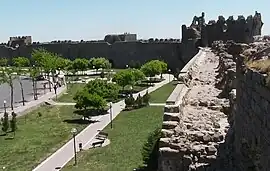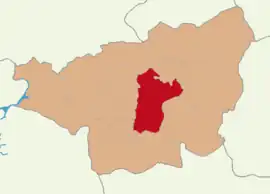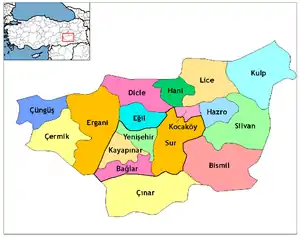Sur | |
|---|---|
District and municipality | |
 Walls of Diyarbakır | |
 Map showing Sur District in Diyarbakır Province | |
 Sur Location in Turkey | |
| Coordinates: 37°54′38″N 40°14′09″E / 37.91056°N 40.23583°E | |
| Country | Turkey |
| Province | Diyarbakır |
| Area | 1,227 km2 (474 sq mi) |
| Population (2022)[1] | 100,613 |
| • Density | 82/km2 (210/sq mi) |
| Time zone | TRT (UTC+3) |
| Postal code | 21300 |
| Area code | 0412 |
| Website | www |
Sur is a municipality and district of Diyarbakır Province, Turkey.[2] Its area is 1,227 km2,[3] and its population is 100,613 (2022).[1] It covers the eastern part of the city of Diyarbakır and the adjacent countryside. The historical Diyarbakır Fortress lies in this district, which takes its name from the castle walls (Turkish: sur).[4]
Background
Sur district was created in 2008 from part of the central district (Merkez) of Diyarbakır.[5][6] It is situated at the Tigris bank, on the felsic lava of the shield volcano Karaca Dağ at an elevation of 600 m (2,000 ft) above mean sea level. Many historic buildings and structures in the district are witness of several civilizations and rich cultures, which were hosted in the location in the history.[4]
The background of Sur goes back to 7500 BC. Archaeological excavations showed that world's oldest settlement was located in the region. Civilizations ruled here are Hurrians (Bronze Age), Mitanni (c. 1500 BC–c. 1300 BC), Hittites (c. 1600 BC–c. 1178 BC), Assur (early Bronze Age), Persians (early 10th century BC), Alexander the Great (356 BC – 323 BC), Roman Empire, Byzantine Empire, Marwanids, Ayyubid Empire and Ottoman Empire.[4]
Politics
The current Mayor is Feyme Filiz Buluttekin.[7] As Kaymakan was appointed Abdullah Çiftçi.[8]
Composition
There are 100 neighbourhoods in Sur District:[9]
- Abdaldede
- Ağaçlıdere
- Alabal
- Alcık
- Alibardak
- Alipaşa
- Arpaderesi
- Bağıvar
- Bağpınar
- Bahçecik
- Baroğlu
- Beybulak
- Bostanpınar
- Bozdemir
- Büyükakören
- Büyükkadı
- Cami Kebir
- Cami Nebi
- Çarıklı
- Çataksu
- Çelikli
- Cemal Yılmaz
- Cevatpaşa
- Çubuklu
- Dabanoğlu
- Dervişhasan
- Doğanlı
- Doğuçanakçı
- Dumrul
- Erimli
- Eryolu
- Esenbağ
- Fatihpaşa
- Fetih
- Fidanlar
- Gencan
- Gölpınar
- Gültepe
- Hacıosmanköy
- Harmanlar
- Hasırlı
- Havacılar
- Hızırilyas
- İskenderpaşa
- Kabasakal
- Kapaklıpınar
- Karabaş
- Karaçalı
- Karacaören
- Karaçimen
- Kardeşler
- Karpuzlu
- Karpuztepe
- Kartaltepe
- Kavaklıbağ
- Kayayolu
- Kengerli
- Kervanpınar
- Kırmasırt
- Konacık
- Köprübaşı
- Köşk
- Koyungüden
- Kozan
- Küçükakören
- Küçükkadı
- Kumluçat
- Kumrucak
- Kuşburnu
- Kuşlukbağı
- Lalebey
- Melikahmet
- Mermer
- Mermeri
- Nefirtaş
- Özekli
- Pınardüzü
- Sağdıçlı
- Sapanca
- Sarıkamış
- Sarılar
- Sarıyazma
- Sati
- Savaş
- Sayarlar
- Soğanlı
- Süleyman Nazif
- Süngüler
- Tanoğlu
- Tezgeçer
- Yarımca
- Yenice
- Yenidoğan
- Yenievler
- Yeşilköy
- Yeşilli
- Yiğitçavuş
- Yukarıkılıçtaşı
- Ziya Gökalp
- Ziyaret
Visitor attractions
Sur is a historic and cultural center. It features historic Diyarbakır houses, Diyarbakır Archaeological Museum, Cahit Sıtkı Tarancı Museum, East Syriac Rite St. Mary's Cathedral, Syriac Orthodox St. Mary Church, St. Giragos Armenian Church, Dicle Bridge, Deliler Inn, Hasan Pasha Inn, Hazreti Süleyman Mosque containing graves of 27 companions of Muhammad, Nebi Mosque, Sheikh Matar Mosque and its Four-legged Minaret, Great Mosque of Diyarbakır and Diyarbakır Fortress as well as caravanserais, madrasas, shadirvans and inscriptions of various historic periods.[4]
2015 conflict and rebuilding of the district
In 2015, militants linked to the banned Kurdistan Workers' Party (PKK) entered Sur district, erected barricades and dug ditches in the streets.[10][11] The local authority banned public gatherings and imposed a 24h curfew in Sur on the 11 December 2015, and the Turkish Army deployed about 200 troops of the Special Forces Command to conduct house-to-house searches.[12][13] The conflict resulted in most residents abandoning their homes.[14] Abandoned houses in various neighborhoods of Sur district were occupied by militants, and clashes between the PKK and Turkish Army and Special Forces continued until early 2016.[15][16]
Amnesty International has estimated that 300,000 people were displaced by the conflict, and branded the government's response 'collective punishment'.[17] International Crisis Group has estimated that around 1,700 people have been killed in the resulting conflict and estimates the number of displaced people at 350,000.[18] Human Rights Watch criticized the Turkish government for 'blocking access for independent investigations into alleged mass abuses against civilians across southeast Turkey'.[19]
Many houses were destroyed and registered historic buildings were seriously damaged. In March 2016, the government launched a project for the restoration of all the damaged historic structures and the rebuilding of destroyed houses in accordance of their original style.[14] However, the project was criticized by the Turkish Union of Architects and Engineers Chambers, who claimed that the project would take “a defense-centered approach”, which would require the destruction of some historic structures.[20]
References
- 1 2 "Address-based population registration system (ADNKS) results dated 31 December 2022, Favorite Reports" (XLS). TÜİK. Retrieved 12 July 2023.
- ↑ Büyükşehir İlçe Belediyesi, Turkey Civil Administration Departments Inventory. Retrieved 12 July 2023.
- ↑ "İl ve İlçe Yüz ölçümleri". General Directorate of Mapping. Retrieved 12 July 2023.
- 1 2 3 4 "İlçenin Kuruluşu ve Kısa Tarihçesi" (in Turkish). Sur Kaymakamlığı. Retrieved 2017-05-18.
- ↑ Kanun No. 5747, Resmî Gazete, 22 March 2008.
- ↑ "İl İdaresi ve Mülki Bölümler Şube Müdürlüğü İstatistikleri - İl ve İlçe Kuruluş Tarihleri" (PDF) (in Turkish). p. 28. Retrieved 25 August 2023.
- ↑ "Diyarbakır Sur Seçim Sonuçları - 31 Mart Diyarbakır Sur Yerel Seçim Sonuçları". secim.haberler.com (in Turkish). Retrieved 2019-11-08.
- ↑ "Diyarbakır Sur Kaymakamlığı". www.sur.gov.tr. Retrieved 2019-11-08.
- ↑ Mahalle, Turkey Civil Administration Departments Inventory. Retrieved 12 July 2023.
- ↑ "Sur'da hendek ve barikatların yüzde 95'i temizlendi". Sabah (in Turkish). 2016-02-15. Retrieved 2017-06-02.
- ↑ "Army: 279 PKK militants killed in Sur operation - LOCAL". Hürriyet Daily News | LEADING NEWS SOURCE FOR TURKEY AND THE REGION. Retrieved 2017-05-30.
- ↑ Ergan, Uğur (2016-01-18). "Diyarbakır Sur'a özel ordu birlikleri girdi". Hürriyet (in Turkish). Retrieved 2017-05-25.
- ↑ (www.dw.com), Deutsche Welle. "Death and destruction in Diyarbakir | Europe | DW | 28.01.2016". DW.COM. Retrieved 2017-05-30.
- 1 2 "Sur nasıl yeniden inşa edilecek?". BBC (in Turkish). 2016-03-26. Retrieved 2017-05-25.
- ↑ "Hürriyet Sur'a girdi teröristler mermi yağdırdı". Hürriyet (in Turkish). 2015-12-29. Retrieved 2017-05-25.
- ↑ "Diyarbakır Sur'daki çatışmaların sıcak görüntüleri". Hürriyet (in Turkish). 2016-02-02. Retrieved 2017-05-25.
- ↑ "Turkish Kurds are heading back to the war-ravaged city of Diyarbakir as a curfew is lifted". The Independent. 2016-03-19. Archived from the original on 2022-05-25. Retrieved 2017-05-30.
- ↑ "Turkey's PKK Conflict: The Death Toll | Crisis Group". blog.crisisgroup.org. Retrieved 2017-05-30.
- ↑ "Turkey: State Blocks Probes of Southeast Killings". Human Rights Watch. 2016-07-11. Retrieved 2017-05-30.
- ↑ "Reconstruction work brings more gloom to southeast Turkey". Al-Monitor. 2017-01-24. Retrieved 2017-05-30.
